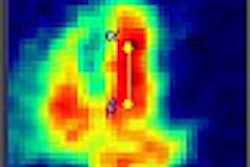SAN DIEGO - The radiation dose exposure to personnel working with PET is typically higher than that of general nuclear medicine. Because of the relatively high photon energy used in the modality, PET offers challenges in radiation exposure, both to radiation workers and to the general public.
In a presentation at the Academy of Molecular Imaging annual conference, Magnus Dahlbom, Ph.D., outlined strategies to minimize the external radiation dose to technologists and other radiation workers in a PET clinic. Dahlbom, a professor of molecular pharmacology in the nuclear medicine department at the University of California, Los Angeles School of Medicine, has found that the widespread use of PET, together with steadily increasing patient volumes, has increased awareness and concerns over radiation safety for the modality.
"Because PET has higher energy, the dose rate is higher and the radiation is more penetrating than in other areas of nuclear medicine. For example, the high energy results in a dose rate that is six times that of 99mTc and requires approximately 16 times more lead for a shielding effect," he said.
The sources of radiation dose to staff are from positrons that are absorbed in the walls of vials and syringes -- significant for internal dose -- and the annihilation photons that are produced when the positrons are absorbed in a 511-keV environment. According to Dahlbom, the main sources of exposure in PET are:
- Isotope production.
- Isotope transport.
- Dose dispensing and calibration.
- Administration of the isotope.
- Patients.
- Transmission scanning.
Although the general rules to reduce external exposure by reducing exposure time and increased source distance are still applicable, the use of PET requires lead barriers, dose dispensing systems or unit doses, and syringe shields specifically designed for PET isotopes, said Dahlbom. It may also be wise to consider rotating personnel, although this may not be practically feasible, he noted.
Tools, such as tongs to push a dose in that limits the exposure rate to a technologist’s thumb during isotope injection, should be mandated in a PET facility. Movable or sliding dose shields should be in place on surfaces that can support their weight. Syringe shields should always be used. For example, a 6 cm tungsten syringe shield reduces the external radiation dose rate of 18-Fluorine to 0.2 mGy per hour vs. the 4 mGy dose rate for an unshielded syringe.
Environmental modifications to the PET area are also critical for reducing dose exposure. This task requires a thorough assessment of the PET installation to determine areas in which additional lead shielding will help eliminate excessive background count rates. Adjacent space occupied by non-radiation workers may also require special considerations.
"Occupancy is a limiting factor when calculating the density of shielding necessary to reduce dose. For example, a nurse station or reception desk would need to be calculated at a 100% occupancy rate in terms of shielding," Dahlbom said.
When determining the amount of shielding for PET, Dahlbom said the following should be considered:
- The number of patients per day.
- The type of isotope injected.
- The percentage of occupancy of the uptake rooms during the day.
- The percentage of occupancy of the scanner room during the day.
- The percentage of occupancy of the adjacent areas during the day.
- What regulations (local/state/federal) are to be followed for exposure rates.
The facility's support structure should be examined carefully before shielding is installed.
"Calculating the correct amount of shielding is of critical importance. However, if your walls and tables can’t support the additional weight, they will start to buckle and deform over time, resulting in a very expensive retrofit," observed Dahlbom.
PET-CT fusion imaging, according to Dahlbom, may require less shielding than a PET-only facility. However, the higher throughput possible through use of this equipment leads to the possibility of higher dose rates to technologists than PET alone.
"The use of proper shielding, conservative exposure-rate calculations when conducting site planning and installing shielding, and optimized technique when administering isotopes will all help to minimize external radiation exposure to the staff of a PET facility," Dahlbom said.
By Jonathan S. Batchelor
AuntMinnie.com staff writer
October 25, 2002
Related Reading
Even moderate doses of radiation may cause nervous system tumors, October 16, 2002
Technique and tools can reduce skin dose during interventional procedures, October 11, 2002
Protective device makes interventional procedures safer for radiologists, September 13, 2002
New protective devices shield interventional radiologists, February 5, 2002
Copyright © 2002 AuntMinnie.com



















